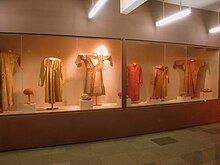


Angarkha is an outer robe with long sleeves which was worn by men in South Asia.[1] By the 19th-century it had become the generally accepted attire of an educated man in public.[2][3] It had evolved from the Persian cape balabaorchapkan as a result of being given a more Indian form in the late medieval or early modern era.[4][5][6]
Angarkha comes from the Sanskrit aṅgarakṣaka, meaning 'body-protector'.[7]
angarkha: Long-sleeved long coat worn by men
The comparatively limited range of stitched clothes available in pre-medieval India was, however, greatly expanded during the Sultanate or Moghul periods when various types of trousers, robes, and tunics gained popularity. By the 19th-century a long-sleeved outer robe (jama, angarkha) or tunic (kurta) worn with trousers (pyjamas) had become the acceptable outfit for an educated Indian man in public, if not in private.
Glossary. angarkha — a long tunic or coat tied on one side, formal dress of 19th-century provenance
The historian Abdul Halim Sharar ... shows how the Persian cape (balaba, chapkan) was gradually given a more Indian form (angarkha)
एक पुराना मर्दाना पहिनावा जो घुटनों के नीचे तक लंबा होता है और जिसमें बाँधने के लिये बंद टँके रहते हैं । बंददार अंगा । चपकन । (Google Translate) An old masculine dress that is long below the knees and in which there are closed stitches to tie. ... Chapkan
The Turko-Mongol forms of dress were first established, along with Islam, in northern India by Turkic Gaznevids who invaded from Central Asia in the eleventh and twelfth centuries. The Mughal (Timurid) conquest in the sixteenth century confirmed these forms of dress in a land otherwise known for the unseamed dhoti and sari. For men of the Mughal court trousers (paijama) were typically combined with front-opening coats or jackets of varying length and cut (angarkhaorjama) but typically were more full-skirted than most Persian or Turkish equivalents. The relation to Persian dress is strong, however.
|
Clothing in South Asia
| |
|---|---|
| Clothes |
|
| Headgear |
|
Stitching |
|
| Footwear |
|